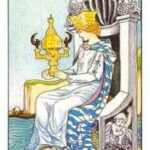It is with great pleasure that I introduce you to my guest blogger, Elaine Mansfield. Elaine and I met about 15 years ago at the Winter Park Jung Center where her husband Vic made a presentation about his newest book. Talking over dinner afterwards, Elaine and I discovered that we had many interests in common, including dreamwork, women’s issues, and mythological studies. We have stayed in touch ever since. The following piece is an especially poignant example of how her inner work helped her through Vic’s cancer and death:

While my husband Vic began chemotherapy in 2006, I absorbed Rainer Maria Rilke’s message in Sonnets to Orpheus: within the darkness of our experience, there is always light. Rilke praised the impermanence of the natural world where all that is born dies. Vic and I lived and loved as he—and we—were also dying.
Ah, the knowledge of impermanence
That haunts our days
Is their very fragrance.
During that chemotherapy autumn while my safe world collapsed around me, I studied Rilke’s sonnets and the myth of Orpheus in a mythology class. Vic struggled, suffered, and kept going. In the chemotherapy room, I watched brave women with scarves askew, bony men with smooth skulls, and angry teenagers with oversized baseball caps concealing their baldness. I saw how each patient balanced their darkness with a call from a friend, the smile of a nurse or companion, or music on their IPod. As I held Vic, the myth held me and taught me what it means to be mortal and live in this world of opposites.
Rilke’s words helped me accept as toxins entered Vic’s veins.
Let this darkness be a bell tower
and you the bell. As you ring,
what batters you becomes your strength.

Rilke helped me see that death is always present in my experience, even in pleasure.
Full round apple, peach, pear, blackberry
Each speaks life and death
into the mouth.
For almost twenty-five years I’d been part of a mythology class with women grounded in Jungian Psychology. We studied the Greek goddesses and gods, a few Eastern European and Asian fairytales, and Inanna’s descent to the underworld to be initiated into the mysteries of Death. Soon after Vic was diagnosed, a class member spotted Sonnets to Orpheus in a bookstore window and suggested we explore the myth of Orpheus.

Orpheus was a demigod, musician, poet, and prophet in ancient Greek mythology. After his beloved wife Eurydice died, he traveled to the Underworld to play his lyre, sing his lament, and gain Eurydice’s release. The beauty of his song convinced Hades and Persephone to grant her freedom, but Orpheus was told not to look back at Eurydice until they were in the Light. Being at least partly human, he glanced back and lost his Love forever to Death.Our group met twice a month and worked on one sonnet each meeting for over two years since there are 55 sonnets. We explored the mythic ideas, read many translations, studied various versions of the Orphic myth, and painted the poetic images—the god, a tree, a lyre. We also included images from personal experiences in our drawings. Within the vessel of this archetypal myth, Rilke’s poems, and a circle of wise, loving women, I remembered that my world of heightened opposites held just as much living as dying.

But life holds mystery for us yet. In a hundred places
we can still sense the source: a play of pure powers
that—when you feel it—brings you to your knees.

Elaine Mansfield’s writing reflects 40 years as a student of philosophy, Jungian psychology, mythology and meditation, and life on 71 acres of woods, fields, and sunset views in the Finger Lakes of New York. Since her husband’s death in 2008, Elaine’s website and blog have focused on bereavement, marriage, and the challenges and joys of her emerging life. Elaine has written a book about love, loss, and new life to be published in 2014. She facilitates hospice support groups for women who have lost partners or spouses and writes for the Hospicare and Palliative Care of Tompkins County newsletter and website and other on line publications.
Rainer Maria Rilke’s poetry is from In Praise of Mortality: Selections from Rainer Maria Rilke’s Duino Elegies and Sonnets to Orpheus.




35 Responses
Elaine and Jean, Thank you for sharing this beautiful, bittersweet story which must be a tremendous source of strength to everyone.
Thank you, Roberta. I’m grateful to Jeanie (see my comment below) for welcoming my work to her site. I usually write about bereavement and creating my new life after the old one ended. I include mythology and Orpheus in my book (coming out in the fall of 2014), but don’t often write about mythology on my blog. It’s been so important to me, but sometimes it’s hard to convey how one might work with a myth. I’m glad this piece feels like a source of strength, and I appreciate your comments and encouragement.
Elaine
It was my pleasure, Roberta. I’ve also discovered the healing power of myths and think Elaine’s post is an unusually good demonstration of the helpful awarenessess one can gain from studying them.
This is very moving and humbling … a candle burns in Scotland to honour Vics life … thank you … I wonder if there is another acre somewhere in your garden to elevate your personal collective to 72 … blessings …
Thank you, Andi. I know that 72 is an important number in various traditions. How are you thinking of it? I rent 1 acre of land in the Finger Lakes National Forest uphill from my property. Long past owners connected a spring on that acre through an underground pipe to gravity feed into a tap in my basement. I water the garden with this water, although we have a deep well for the house. Anyway, we could with a stretch call that acre mine as long as I pay the yearly fee and then I can say I live on 72 acres. Good? In fact, I border thousands of acres of National Forest. And blessings to you.
Hello Andi,
Your lit candle reminds me to light my own this afternoon in honor of Vic and Elaine and their combined rich legacy as a couple.
I was wondering what 72 means to you as well. In terms of number symbolism, one could add 7 and 2 to arrive at 9: the number of the Goddess and also the number of challenges, discrimination, and completion. Other meanings include the Seat of Karmic Justice and Pure Sight, Powers of Law and balance, perfection and the end of a cycle.
In numerology, personality characteristics associated with one whose number is 9 include observant, perceptive, motivated by truth, fairness, and justice, broad-minded, generous, responsibility, duty, service, sacrifice, selflessness, power.
There’s much to think about here. Thank you for stopping by and blessings back to you,
Jeanie
Elaine and Jean,
Thank you for sharing these powerful images and meditative words here. In my grief following my husband’s death, one hard-learned lesson is that darkness can provide safety and warmth, offering a hidden place where transformation becomes possible. Darkness and light: There is no wholeness without both.
Kathleen
I so agree, Kathleen. I love this Rilke Elegy:
“How dear you will be to me then, you nights
of anguish. Why didn’t I kneel more deeply to accept you,
inconsolable sisters, and, surrendering, lose myself
in your loosened hair. How we squander our hours of pain.
How we gaze beyond them into the bitter duration
to see if they have an end. Though they are really
our winter-enduring foliage, our dark evergreen,
one season in our inner year—, not only a season
in time—, but our place and settlement, foundation and soil and home.”
~ Rainer Maria Rilke. Duino Elegies. “The Tenth Elegy.” Translated by Stephen MItchell.
I did not push aside my deepest grief or try to get over it. I surrendered and found faith in the transformative process. I found help in many ways. I’m sorry you lost your husband, too. We are a world-wide club by necessity, not choice.
Thank you for reading my piece and for your loving response,
Elaine
Dear Kathleen,
The value of grief as an aid to transformation is a beautiful and very important insight! I’ve experienced it and have also seen a powerful transformation in Elaine since Vic died. Alchemy, myth, Christianity, Hinduism, Buddhism, Jungian psychology and many other traditions affirm that the tendency to devalue the dark and yearn for the light is a mistake that derails progress on the spiritual journey. I’m grateful to you and Elaine for reminding us of this truth.
Blessings,
Jeanie
Dear Jeanie,
Thank you for posting my article and using my amateur straight-from-the-heart art work. This post is an experiment since I’ve tried to write about mythology many times, but it often seemed a bit dry and dull. This time I used my natural personal style and talked about how the Sonnets to Orpheus and the myth moved and held me. I’m grateful for this wonderful opportunity, since I knew mythology would be welcome at your Jungian-oriented site.
Thanks again for your generosity and support. It’s a wonderful gift that we’ve kept connection for many years. I happily remember a dinner shared with you, your husband, and mine. Two Italian gentlemen who immediately hit it off.
Warmly,
Elaine
Dearest Elaine,
I’m honored to share your post here and honored to know you, my Wisewoman friend. Your devotion to the inner life and ability to ground and balance it with equal passion for physical life shines through everything you write. I cannot wait for your new book to be published! I know it will be an inspiration to all who read it.
We are indeed fortunate to have had our Italian gentlemen in our lives aren’t we? They’ve played huge roles in our personal transformations! I wonder what it is about some Italian men that brings out the best in some non-Italian women…
Love,
Jeanie
Dear Elaine and Jeanie,
James Hollis’ words came to me whilst I was reading…
‘Cast upon the high seas of the soul, alone, I have learnt to value that journey as my home’
‘None of us who have gone through such sea-changes have ever volunteered. We were dragged there, kicking and screaming, and no doubt [in this life] we will be dragged there again’
Coincidentally [or not!] last week on my 50th birthday my partner brought me a copy of Rilke’s ‘Sonnets to Orpheus’….I can’t wait to get started! Thank you Elaine for illuminating my knowledge of impermanence. I have found clarity and deep meaning within your words. And thank you for breathing life and colour into your wonderful straight-from-the-heart words and images that you have shared so generously with us here.
Blessings,
Deborah x
Dear Deborah,
Well now I’m feeling very left out! I must be the only person I know who hasn’t read “Sonnets to Orpheus.” I shall order myself a copy forthwith!!!! 🙂 Thank you for writing, Deborah, and for your kind words to Elaine. She does have a way of breathing life and color into everything she does!
Blessings,
Jeanie
What a wonderful set of quotes from James Hollis, Deborah. Thank you. By good fortune and grace, although we did not volunteer for what happened, Vic surrendered to his fate, dealt with his fear of death openly (and was relieved of that fear in his last six weeks, and used his last two years to practice kindness. He’d been a serious practitioner of meditation and philosophy as well as Jung and had always been kind, but he focused on this quality. He became a true student of the Dalai Lama who says “Kindness is my religion,” and his loving kindness rubbed off on everyone, especially me.
I love the Sonnets to Orpheus–and they can be hard going and dense as well as accessible, depending on the sonnet. The Anita Barrows and Joanna Macy translation I used in these quotes is most accessible, but not always considered the most scholarly. We used many translations and even had a German woman in the class. She felt that the Barrows/Macy translation translated the heart of the poetry more than some others. She was a big help with obscure ideas or idiomatic phrases. I took great comfort in them and loved painting the images. I have a painting for each sonnet, and although I am no artist, it was a wonderful way to make the sonnets personal and lasting.
Elaine and Jeanie,
Thanks so much for this beautiful, hopeful and touching entry. I get so much from my Wisewomen friends. And the illustrations are gorgeous.
Thank you, Phyllis. My tempera and oil crayon “masterpieces” meant so much because I had found an image from the sonnet that touched my soul, similar to the way one might illustrate a powerful dream image. (I do that, too.) Occasionally, everyone in the class chose the same image such as the lyre or a willow tree, but often we resonated with different images. It was interesting to see what image each woman found compelling and how she portrayed it–especially the artists in the group. I love that phrase from the Sonnets, “A Gust in the God. A Wind.”
Thank you, Phyllis. I wish every woman the good fortune to have Wisewomen friends and guides on the inner journey.
And thank you, Elaine for pointing out that the value of your images lay in the fact that they captured something that touched your soul. Each creative image you made told not just Rilke’s story, but the story of your own soul’s journey. This is a perfect “illustration” of soul-making. By manifesting each small truth in a creative way you strengthened your soul, leading it step by step from the depths of the unconscious into the light where it has become your ego’s constant companion and advisor. This, and not just learning from books, is how a Wisewoman comes into being.
I drew/painted the two images of “The Gust in the God,” when we learned that after chemotherapy Vic would be in an experimental group to undergo a stem cell transplant. I dated the drawings and just checked that. It was an alarming procedure. Vic’s white blood cells would be demolished with a deadly amount of high dose chemotherapy and then we would wait for the god(dess) to breathe new life into him after infusion of previously harvested stem cells. It was the breath of life and the beauty of the Orphic lament that touched me deeply. Certainly, the value wasn’t in the artistic merit. 😉
Thank you for sharing this. I facilitate dream work and guided imagery with cancer patients and am in touch with several young professionals who are developing ways to bring inner work practices into the health care arena. I will forward this post to them and others who will be grateful for this wisdom.
Wow, Tallulah. That’s wonderful. When (and before) my husband Vic was ill, we worked on our dream images together, with Robert Bosnak (a Jungian therapist) in dream workshops, and also with Marion Woodman. when Vic was ill, I read the sonnets to him and we talked about them, but he didn’t draw them. He did draw his dreams sometimes. He had a Ph.D. in astrophysics and wrote about Jung, Buddhism, and Physics, but put an oil crayon or a water color brush in his hand and he was an inadequate 5 year old. He allowed the unconscious to go to work on the images that helped him through his experience. It is powerful soul work when threatened by cancer and facing mortality. I’m sure you help so many patients, and I’m honored that you like my post enough to pass it along.
Another story comes to mind: Vic’s last talk was just five weeks before his death at Grand Rounds in a large teaching hospital. He spoke about how essential it is to recognize and nurture the soul of those who are frightened and ill. He was fascinated by the science of the scans, tests, and details of his unusual and rare cancer, but as a human being, he needed more than a report of findings. I thought it a fitting last lecture for a man who knew how to bring together mind and heart.
Thank you for sharing this, Tallulah. I admire your soul-healing work so much!
For Elaine and others who many not know this, Tallulah Lyons is also an author. Her two books are Dream Prayers: Dreamwork as a Spiritual Path, and Dreams and Guided Imagery: Gifts for Transforming Illness and Crises.
Thanks for this information, Jeanie. I did not know and will look up these books. Both titles sound relevant to this discussion.
Thanks very much for providing the link to this post on your excellent blog! Blessings.
There is so much here to absorb. I’m slowly learning to apply these and other lessons to my own grief work. As always, I enjoy seeing new layers of my online friend, Elaine, and her circle of friends. Beautiful words and images! I hope to carry her grace forward on my own journey.
Yes, Elaine’s way of sharing her story is truly a blessing to so many. Thank you for stopping by here to partake of it. Sending you my blessings too, Jeanie
Thank you, Jeanie and I appreciate the space you give to others in order to share their talents and insights.
Patti, I’ve studied women’s mythology for 25 years and Jungian Psychology since the 1960s. Jeanie gave me a chance to explore a little of that work with her audience. My approach is strongly influenced by Marion Woodman. I met Marion in 1986. (I met Jeanie in the late 1990s, only once.) I love sharing this piece with you.
Jeanie has written three books. I review her last one ‘Healing the Sacred Divide’ at Amazon. It’s a mind and heart-opening exploration of the healing power of the sacred feminine.
Thanks, Elaine, I’m working on looking up all the mentioned writers:>) I’m so glad that you took Jeanie up on her offer!
Dearest Elaine, Blessings, and thanks for your deep commitment to meaning making…
Thank you, Gita, for your affirmation of Elaine’s work.
Thank you Gita, for being on the meaning-making trail with me and for reading this new piece about our work.